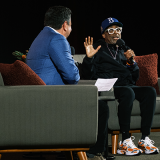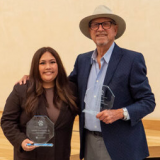Hands-On Studio Lighting Workshop
March 29, 2012
The FTV 114: Introduction to Television Production: Studio class had a real treat last week.
Special guest Mike Thornburgh was in the TV Studio for the past two days, for an extended workshop on lighting for the TV Studio. For two hours each day, students got hands-on techniques, tips, training, and exercises on the unique aspects of ligthing a scene for the high-intensity stage, and demanding camera actions needed to bring a TV scene to life.
Mike’s work includesa a variety of TV shows, and his principal work was on soap operas like Young and the Restless,One Life to Live, and Ryan’s Hope. However, you can see some of his best work in the Emmy nominated classic All My Children.
On day 2, students tried out three separate ligthing scenarios, mainly shot in the foreground of the studio (more on that later), using mutliple camera shoots, and studied how to keep the whole set lit throughout. On a typical TV sitcom, the stage must be lit almost entirely from edge to edge, to allow for a variety of different camera angles to pick up the action. Since each camera is rolling throughout a scene, and far fewer retakes are allowed than a feature production, for example, the need to keep the details in focus and lit make the lighting requirements much more stringent.
Even something as simple as walking across the stage becomes a more complex process for the ligthting directors than you might imagine. While the cameras pan, the highlights and shadows present on a face, and on clothing, change dramatically in relation to the position of the spotlights and the cameras, even while they remain largely fixed to the floor.
Having very clear stage markers and stage directions also becomes very important, since the lights and camera remain stationary, and the actors’ movements cause them to move quickly in and out of the light. In a couple examples,a student actor would accidentally move just a couple steps beyond their mark, in their enthusiasm to enact the scene, and suddenly be plunged into darkness. The edges of the lighting lit stage are not forgiving!
There is a “sweet spot” where the best camera shots occur. Keeping this in mind, the boom placement becomes necessary to plan as well, since they will pick up audio in a far smaller range than can be easily lit. This ‘sweet spot’ is small – barely 3 feet deep, in front of the prosceenium (the area of the stage separating the fixed TV cameras and the acting stage. The sweet spot is the easiest to light, which also ends up determining the stage design of the furniture. Each foot, even each inch, beyond the sweet spot, becomes increasingly harder to light, requiring more camera movements, key lights, and so on. Within a TV show’s tight budget, both in terms of time and money, simple details like these must be synergized, so the complications of the stage end up impacting the complexity of the story, in a way that doesn’t affect the viewer’s experience. Take for example, interior design – whereas a typical house would have furniture placed against the walls, a multicamera sitcom simply often doesn’t have the budget to allow for a set’s complexity to allow for a scene to be lit and shot in both the foreground (“the sweet spot”) and the background. This leads to the typical ‘floating’ furniture set in the middle of the room, all faced outwards towards the invisible fourth wall.
Of all these details, one thing that struck me is the difficulty of shooting a conversation taking place through a doorway. The beams framing the door almost always block part of the light on the actors’ faces, no matter where the camera is positioned. With the backstage lights, upstage crosskeys, and acting as both key lights and backfill lights, even a minor change in camera angle or actor position can cause huge headaches for the lighting crew.
It just goes to show how much we take for granted while watching TV – even a simple through-the-door shot can be incredibly complicated. We were thrilled to have Mike here to show our students how it’s done!


